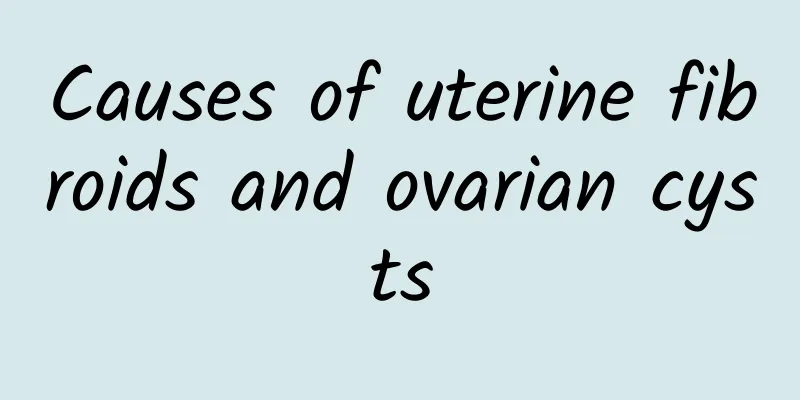Causes of uterine fibroids and ovarian cysts

|
Uterine fibroids and ovarian cysts are common female reproductive system diseases, which are closely related to genetic factors, hormone disorders, and bad living habits. They need to be managed and prevented through standardized medical examinations and treatments. The following is a detailed analysis of the causes of these two diseases and related precautions from multiple perspectives: genetics, environment, physiology, and pathology. 1. Genetic factors Uterine fibroids are related to family heredity. If there is a history of the disease in a direct relative, the risk of the disease may increase. Some types of ovarian cysts are also related to genetic background, especially in patients with polycystic ovary syndrome, where family members often have a similar medical history. If a woman has a genetic risk, she should undergo regular gynecological examinations and early monitoring. 2 Environmental factors Long-term exposure to harmful environmental hormones such as plasticizers, estrogen pollution and other chemicals, or excessive intake of hormone-containing foods in life, can cause hormone disorders in the body, thereby increasing the risk of uterine fibroids and ovarian cysts. Long-term lack of exercise or high psychological stress may also indirectly cause these two diseases by affecting the endocrine system. Avoiding the use of hormone drugs, reducing contact with plastic products, and exercising more can help reduce the risk. 3 Physiological factors The occurrence of uterine fibroids is often closely related to the continuous increase of estrogen levels in women. For example, multiple pregnancies, high-fat diets or obesity can lead to excessive secretion of estrogen, which can stimulate excessive proliferation of the uterine muscle layer. Ovarian cysts may be caused by abnormal ovulation function, such as the formation of cysts due to the development of follicles or failure to completely disappear after ovulation. Maintaining a regular menstrual cycle and a proper weight is particularly important for managing estrogen levels and reducing the occurrence of lesions. 4 Traumatic factors Uterine operations such as cesarean section and artificial abortion may damage the uterine muscle layer and increase the risk of uterine fibroids. Similarly, some causes of ovarian cysts may be related to ovarian tissue damage, such as tissue reaction after ovarian surgery or other traumatic factors that can cause cyst formation. It is very important to minimize unnecessary gynecological operations and choose experienced doctors for necessary treatment. 5 Pathological factors Uterine fibroids are benign tumors caused by the proliferation of uterine smooth muscle, which manifest as abnormally proliferating small nodules around the uterus, while ovarian cysts can be divided into functional cysts that disappear after spontaneous absorption and organic cysts such as ovarian tumors. The former is usually caused by endocrine disorders, while the latter may be an external manifestation of more serious lesions. Regular ultrasound examinations and biochemical monitoring can help accurately identify lesions and take appropriate interventions. The occurrence of uterine fibroids and ovarian cysts is the result of the combined effects of multiple factors. Avoiding a high estrogen environment, maintaining a healthy lifestyle, and having regular gynecological examinations can reduce the risk of these diseases. If you have been diagnosed, you need to choose observation, medication, or surgery under the guidance of a doctor to maintain your health. |
<<: Can I have a baby after having my cervix removed?
>>: What seafood can you eat during pregnancy?
Recommend
How to lower cholesterol without medication? Nutritionist Lin Yuwei: 5 tips to adjust your lifestyle and improve your cholesterol
How to lower cholesterol without medication? Some...
What to do with menstrual pain? Usually it is blood stasis
Menstrual pain is usually caused by blood stasis....
Causes of chocolate cysts
As a high-incidence disease, chocolate cyst disea...
What should I do about malignant uterine fibroids? What are the symptoms of malignant uterine fibroids?
Uterine fibroids are a common disease in women. M...
Want to lose weight successfully? Taking photos to keep this daily record is the first step to success!
Debunking the lie of "genetic obesity" ...
Which gynecological hospital in Shenyang is recommended?
Which gynecological hospital is good in Shenyang?...
What are the harms of abortion anesthesia to the body? What should women pay attention to after abortion
Painless abortion is very common nowadays, and mo...
What medicine can cure the symptoms of candidal vaginitis
Vaginal candidiasis can usually be treated with t...
Dietary treatment for delayed menstruation
Delayed menstruation is a common symptom of irreg...
Brief analysis of important precautions for adnexitis
During the treatment and recovery of adnexitis pa...
Symptoms of menopause
Menopause is the time when female patients experi...
Are uterine cysts and uterine fibroids the same?
Uterine cysts and uterine fibroids are different,...
Can I have sex with a condom ten days after an ectopic pregnancy?
It is not advisable to have sex within one month ...
Can I have sex after an abortion?
Within one month after an abortion, the wound on ...
What are the mid-term exercises for cervicitis?
Cervicitis is a common disease among women of chi...









